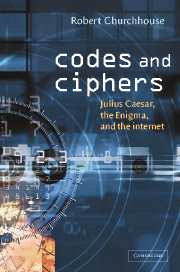Book contents
- Frontmatter
- Contents
- Preface
- 1 Introduction
- 2 From Julius Caesar to simple substitution
- 3 Polyalphabetic systems
- 4 Jigsaw ciphers
- 5 Two-letter ciphers
- 6 Codes
- 7 Ciphers for spies
- 8 Producing random numbers and letters
- 9 The Enigma cipher machine
- 10 The Hagelin cipher machine
- 11 Beyond the Enigma
- 12 Public key cryptography
- 13 Encipherment and the internet
- Appendix
- Solutions to problems
- References
- Name index
- Subject index
7 - Ciphers for spies
Published online by Cambridge University Press: 13 August 2009
- Frontmatter
- Contents
- Preface
- 1 Introduction
- 2 From Julius Caesar to simple substitution
- 3 Polyalphabetic systems
- 4 Jigsaw ciphers
- 5 Two-letter ciphers
- 6 Codes
- 7 Ciphers for spies
- 8 Producing random numbers and letters
- 9 The Enigma cipher machine
- 10 The Hagelin cipher machine
- 11 Beyond the Enigma
- 12 Public key cryptography
- 13 Encipherment and the internet
- Appendix
- Solutions to problems
- References
- Name index
- Subject index
Summary
A spy operating in country X on behalf of country Y has the problem of communicating with his controller in such a way as to protect both himself and the contents of his messages. No matter how he sends his messages they will have to be ‘modified’ somehow so that their true meaning is hidden from anyone but the intended recipient. There are methods, such as the use of microdots or ‘invisible’ ink, which do not, per se, involve encipherment although some ‘modification’ of the text even in such cases would probably be used to provide extra security. When we say that a text has been ‘modified’ we do not necessarily mean that it has been enciphered but that the ‘secret’ text is not simply sent in an unaltered form: it might, for example, be hidden inside an apparently innocuous message.
Hiding a secret text inside an innocuous one has the advantage that, being apparently unenciphered, it will not automatically attract the interest of unintended recipients or interceptors, such as the security forces of country X. A disadvantage is that it may not be too easy to construct a realistic non-secret text in which to embed it. Here is a simple illustration.
Example 7.1 (‘Part of a letter from Agent 63’)
As I was walking through the centre of town yesterday morning at about eleven thirty I chanced to see Ron Kingston. He was alone, driving a newish-looking ultramarine car, a Ford Escort. Previously he's had only second-hand cars, not often less than three years old.
- Type
- Chapter
- Information
- Codes and CiphersJulius Caesar, the Enigma, and the Internet, pp. 72 - 93Publisher: Cambridge University PressPrint publication year: 2001



